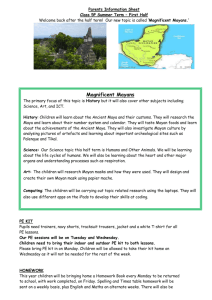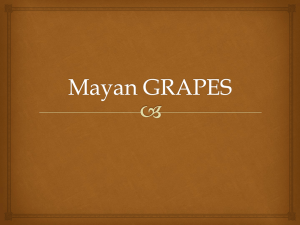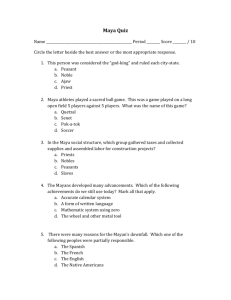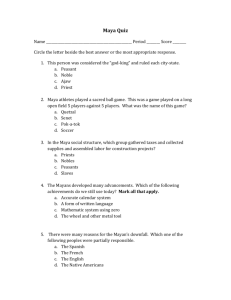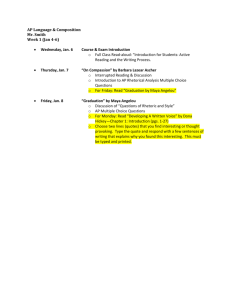Mayan Culture3
advertisement
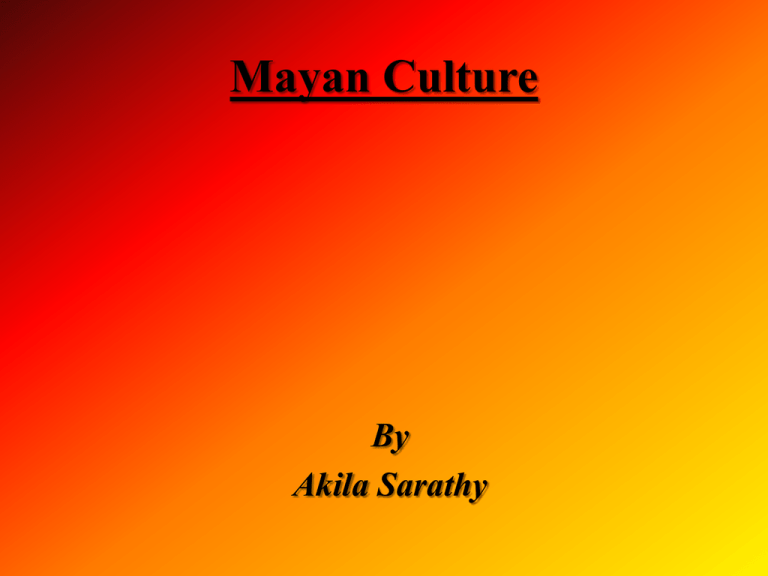
Mayan Culture By Akila Sarathy History B.C. • 11,000: The first hunter-gatherers settle in the Maya highlands and lowlands. • 2000: The rise of the Olmec civilization, from which many aspects of Maya culture are derived. Village farming becomes established throughout Maya regions. • 100: The city of Teotihuacán is founded and for centuries is the cultural, religious and trading centre of Mesoamérica. A.D. • 400: The Maya highlands fall under the domination of Teotihuacán, and the disintegration of Maya culture and language begins in some parts of the highlands. • 500: Tikal becomes the first great Maya city, as citizens from Teotihuacán make their way there, introducing new ideas involving weaponry, captives, ritual practices and human sacrifice. • 600: An unknown event destroys the civilization at Teotihuacán, along with the empire it supported. Tikal becomes the largest city-state in Mesoamérica. • 1283: Mayapán becomes the capital of Yucatán, as the League of Mayapán rules the country. • 1441: There is a rebellion within Mayapán and the city is abandoned by 1461. After this, political union is lost in Yucatán. Sixteen rival groups compete among themselves to rule over the others. • 1517: The Spanish first arrive on the shores of Yucatán under Hernández de Córdoba • 1528: The Spanish under Francisco de Montejo begin their conquest of the northern Maya. The Maya fight back with surprising vigor, keeping the Spanish at bay for several years. • 1541: The Spanish are finally able to subdue the Maya and put an end to Maya resistance. Revolt continues, however, to plague the Spaniards off and on for the rest of the century. History . A.D. • 1880: A new tide of Spanish government intervention in Mayan life begins as the Spaniards attempt to force the Mayans to become laborers on cash-crop plantations. This destroys many aspects of Mayan cultural tradition and agricultural methods preserved for over 4,000 years. Towns which had been protected for the Mayan soon become a haven for mixed-race Latinos who preyed economically on the indigenous Mayans and usurped all positions of social and economic power. • 1901: The War of the Castes comes to an end. • 1994: Chiapas Maya, Tzeltal and Tzotzil in their majority, rise against the Mexican government, taking the city of San Cristóbal de las Casas. Location • Past: Southeastern México; Guatemala; Belize; Honduras; El Salvador • Present: Southeastern México; Guatemala; Belize; Honduras; El Salvador Climate • Rainy, hot, dry, & tropical. Resources • Tropical swampland was converted into vast tracts of agricultural land • Discovered stones and minerals like flint, jade, obsidian, iron pyrite, cinnabar and hematite. . Some of the minerals were used for dyes and colors in ceremonies but others, like flint, were put to use constructing tools • Clays were used to create decorative as well as utilitarian bowls and drinking cups. • The Mayans learned to harvest fish and shellfish and use oysters and clam shells as tools. Economic Lifestyle Agricultural: • The Mayans would clear the land by cutting down and burning all of the foliage in the spring before the summer rains. Then they would plant their crops by poking digging sticks into the ground and planting the seeds in the holes. The slash and burn technique means that the fields would only be fertile for a few years. The Mayans practiced crop rotation to get more growing seasons out of the field. Decline Of Status • • • • • Key reasons for the decline of the Mayans were failing infrastructure and defeat by the Spanish who seized their land and subjugated the people. The Spanish created new nuclear settlements laid out in a grid pattern in the Spanish style, with a central plaza, a church and the town hall housing the civil government. This style of settlement can still be seen in the villages and towns of the area. The civil government was either run directly by the Spanish and their descendants (the ladinos) or was tightly controlled by them. The introduction of Catholicism was the main vehicle for cultural change, and resulted in religious syncretism. Old World cultural elements came to be thoroughly adopted by Maya groups, an example being the marimba, a musical instrument of African origin. However the greatest change was the sweeping aside of the pre-Columbian economic order and its replacement by European technology and livestock; this included the introduction of iron and steel tools to replace Neolithic tools, and of cattle, pigs and chickens that largely replaced the consumption of game. New crops were also introduced. Sugarcane and coffee led to plantations that economically exploited native labor Migration Of Culture • The Mayans remained where their ancestors first settled. They never migrated out of this region. Government • A typical classic Maya polity was a small hierarchy headed by a hereditary ruler known as an ajaw. Such kingdoms were usually no more than a capital city with its neighborhood and several lesser towns, although there were greater kingdoms, which controlled larger territories and extended patronage over smaller polities. • Despite constant warfare and eventual shifts in regional power, most kingdoms never disappeared from the political landscape until the collapse of the whole system in the 9th century AD. • In this respect, Classic Maya kingdoms are highly similar to late Post Classic polities encountered by the Spaniards in Yucatán and Central Mexico Relationships • Both nuclear and extended families are found among the Maya. • Couples generally marry in their late teens or early twenties. • Traditionally, all marriages were arranged, but since the 1950s it has become increasingly common among some groups for young people to choose their own mates. • In arranged marriages, contact may be initiated by the couple, followed by negotiation between the two families. Culture • The Maya have preserved many aspects of their ancient culture, including their traditional clothing, folklore, agricultural techniques, family structure, language, and dance. • Many elements of their ancient religions have also survived for centuries under the guise of Catholic religious observances. Contributions To Society/World • Writing, math, & astronomy. • Maya were scientists in the fields of mathematics, astronomy, agriculture, architecture and engineering; they were great artists in the fields of sculpture, painting, weaving and carving. • The Mayas discovered the zero value in mathematics, at about the same time that it was discovered in India and later passed on to the Arabs. Their astronomic forecasts based on mathematical calculations and scientific observations were amazing, and still are. They prepared a calendar more accurate than the Gregorian, and in the field of medicine they performed intracranial surgical operations Religion Belief System I • The Mayans worshipped everything in nature and tried to explain how things happened because of the ‘Gods’. • They believed that the world was made up of heavens and underworlds. They were linked together by a giant tree, which had its branches in the heavens, and it's roots in the underworld. • They believed that every person had an animal companion spirit. • When the person was born the same soul would also be placed in an animal's body. It was believed that people could transform into their animal companion. Religion Belief System II • Sacrifice was a religious activity in Maya culture, involving either the killing of animals or the bloodletting by members of the community, in rituals superintended by priests. • Sacrifice has been a feature of almost all premodern societies at some stage of their development and for broadly the same reason: to propitiate or fulfill a perceived obligation towards the gods. Music • Made whistle flutes, bone flutes, drums, and rattling cups. Literature • The Paris Codex, Dresden Codex, Grolier Codex, and Madrid Codex are the few books that survived the book burnings by the Spanish. They are collectively called Codex Tro-Cortesianus. • Paris Codex: Devoted almost entirely to Mayan ritual and ceremony, such as the ceremony held to celebrate the end of a 20-year period. The codex is fragmentary and is composed of paper made from tree bark, fashioned in a long strip and folded like a screen. • Dresden Codex: It contains astronomical calculations, eclipse-prediction tables, the synodical period of Venus of exceptional accuracy. • Grolier Codex: A codex fragment consisting of 11 damaged pages from a presumed 20-page book. Deals with the Venus calendar. • Madrid Codex: Contains a wealth of information on astrology and on divinatory practices. It has been of particular value to historians and anthropologists interested in identifying the various Mayan gods and reconstructing the rites that ushered in new years. Art • The Maya used great complexity of patterns and a variety of media expressions. Limestone structures, faced with lime stucco, were the hallmark of ancient Maya architecture. • The Mayans also designed works of art from flint, bone and shell, along with making decorated cotton textiles. Even metal was used for ceremonial purposes. Clothing Women: • The huipil is a garment worn as a blouse by Mayan women since ancient times. It is a square or rectangular piece of cloth with a hole in the center. It is generally embroidered around the neck, in the shape of a cross. The huipil is worn over a skirt which is tied with a woven belt. Men: • wear a shirt, pants, a hat, and usually a sash or belt. Customs • • • • • • • • Marriage: Arranged marriage. Usually the bridegroom does bride service. Couples are based on compatibility of their horoscopes. Death: The Maya dead were laid to rest with maize placed in their mouth. Maize, highly important in Maya culture, is a symbol of rebirth and also was food for the dead for the journey to the otherworld. Birth: Praying is considered key in the delivery of a child, and as soon as the midwife is informed of a birth she begins praying. She is also expected to pray before entering the house and before touching the pregnant woman. She must also pray to each of the four corners of the room which is said to house invisible guardians. The final Ritual that must be performed is the sweeping and cleaning of the room before she leaves. She then prays one last time, thanking the spirits for a successful delivery. Celebrations: what was a ritual? Blood sacrifice Was a ritual of the Maya people, which dates back to ancient Mesoamerica. It was also a common practice for other cultures, but is generally associated with the rituals of the Maya. The Maya believed that the gift of blood to the gods, especially royal blood, was crucial to their well-being, and that it validated their worthiness in the Maya community Cuisine • Maya diet focused on four primary domesticated crops (staple foods): maize, squash, beans (typically tepary beans or common beans) and chili peppers. • When incorporated together in a diet they complemented one another in providing necessary nutrients. • Paramount among the three, maize (corn) was the central component to the diet of the ancient Maya, and figured prominently in Maya mythology and ideology • The Maya adopted a number of adaptive techniques that, if necessary, allowed for the clear-cutting of land and re-infused the soil with nutrients. Among these was slash and burn, or swidden, agriculture, a technique that cleared and temporarily fertilized the area to be cultivated. • The Mayan’s diet hasn’t spread to other parts of the world. Education • Education was taught to only the higher authority such as priests, leaders/chiefs, war leaders. • The rest of the Mayan population were educated at home. Parents taught their offspring information that they knew from their own life experiences and this information was passed down through generations. Technology • Mayan tools ( including weaponry) were made from bone, parts of animals, soil, stone, metal/copper, and wood. Cited Sources • • • • • Harrison, Peter D., and B. L. Turner. Pre-Hispanic Maya agriculture. Albuquerque: University of New Mexico Press, 1978. Print. "Maya - Government." Kidsnewsroom.org: providing children with a safe, kidfriendly Internet site.. N.p., n.d. Web. 4 June 2012. http://www.kidsnewsroom.org/elmer/infocentral/frameset/civilizations/maya/gov>. "Paris Codex (Mayan literature) -- Britannica Online Encyclopedia." Britannica Online Encyclopedia. N.p., n.d. Web. 4 June 2012. <http://www.britannica.com/EBchecked/topic/443839/Paris-Codex>. "The Temple of Information." Rice University -- Web Services. N.p., n.d. Web. 4 June 2012. <http://www.ruf.rice.edu/~jchance/mayainfo.html>. "Burial Customs." New Page 1. N.p., n.d. Web. 4 June 2012. <http://connections.smsd.org/csi/burial


